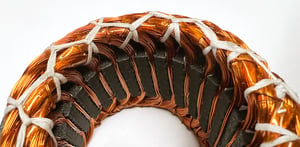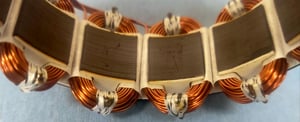Distributed and concentrated windings represent two common configurations for the windings found in electric stators for electric motors and generators. Here are the primary differences between them:
Manufacturing Complexity and Cost
-
-
Distributed Windings: The manufacturing of distributed windings commonly requires meticulous coil insertions and precise connections, adding complexity and cost. The benefit is a design that consistently delivers motors that boast unparalleled performance and efficiency.
-
Concentrated Windings: While concentrated windings boast a simpler manufacturing process with fewer coils and connections, it's important to note the potential drawbacks. Though cost savings are achieved, there's a trade-off – these windings may not deliver optimal efficiency or consistently smooth performance in certain applications.
-
Winding Placement and Arrangement
-
-
Distributed Windings: In distributed windings, the coils are laid uniformly along the entire circumference of the stator core. Each coil spans multiple stator slots and is interconnected to form a continuous winding that covers the entire core periphery. This design helps to achieve a more smooth and uniform magnetic field distribution, reducing harmonics and improving the overall performance of the motor.
-
 Concentrated Windings: In concentrated windings, the coils are concentrated within a limited number of stator slots. Each slot typically contains a single coil. Concentrated windings are more localized and don't cover the entire core periphery. This can lead to a less uniform magnetic field and increased harmonics.
Concentrated Windings: In concentrated windings, the coils are concentrated within a limited number of stator slots. Each slot typically contains a single coil. Concentrated windings are more localized and don't cover the entire core periphery. This can lead to a less uniform magnetic field and increased harmonics.
-
Thermal Performance
-
-
Distributed Windings: The distributed nature of the windings allows for better heat dissipation. The heat generated during operation is spread out over a larger area, reducing the risk of localized hotspots. This configuration often contributes to improved thermal performance, making distributed windings suitable for applications where efficient heat dissipation is crucial, such as in high-duty-cycle operations or high-power applications.
-
Concentrated Windings: Concentrated windings, with coils concentrated in specific slots, may experience higher local heating. The limited spatial distribution of coils can result in localized temperature increases. This configuration might pose challenges in managing heat, especially in high-performance applications where thermal considerations are essential.
-
The choice between distributed and concentrated windings depends on the specific requirements of the motor or generator's application. Distributed windings are often preferred for high-performance and precision applications where low harmonics and smooth operation are critical, while concentrated windings may be more suitable for cost-sensitive applications where a slight reduction in performance is acceptable.
.jpg?width=926&height=176&name=eec_cmyk_notag-(maroon).jpg)

.png?width=949&name=eec_cmyk_notag-(white).png)